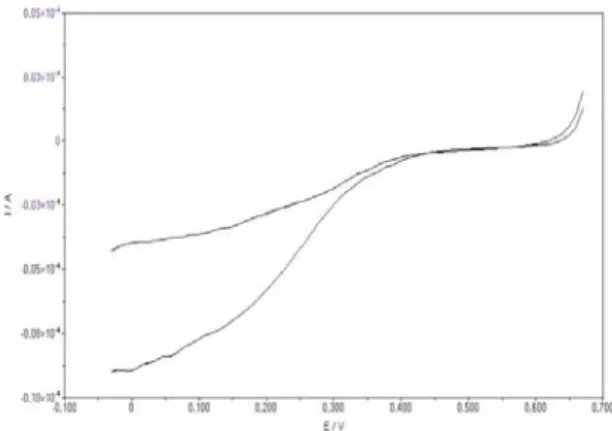Mechanism of Bilirubin Oxidase:
Fabrication and characterization of efficient biocathode Magnus Falk*, Viktor Andoralov*,§, Curt T. Reimann^, Tautgirdas Ruzgas*, Martin Srnec¤, Ulf Ryde^, Lubomír
Rulíšek¤, and Sergey Shleev*,#,^ *
Biomedical Laboratory Science and Technology, Health & Society, Malmö University Södra Förstadsgatan 101, SE-205 06 Malmö, Sweden #A.N. Bach Institute of Biochemistry, Moscow, Russia ^Theoretical Chemistry, Lund University, Lund, Sweden
§
A.N. Frumkin Institute of Physical Chemistry and Electrochemistry, Moscow, Russia ¤
Institute of Organic Chemistry and Biochemistry, Gilead Sciences Research Center & IOCB, Praha, Czech
Republic
To elucidate the mechanism of bilirubin oxidase (BOx) function in order to design efficient and stable biocathodes working at different conditions, the enzyme was studied thoroughly. BOx is a copper-containing redox enzyme that catalyzes the oxidation of a variety of different organic and inorganic compounds with concomitant reduction of O2 directly to H2O.
The catalytic site of BOx consists of four copper ions classified into three types: Cu-T1, Cu-T2, and Cu-T3. The latter two are often denoted the Cu-T23-cluster. In order to asses the enzymatic turnover for BOx three processes needs to be considered: electron donation from reduced substrate or negatively polarized electrode, intramolecular electron transfer (IET) from the Cu-T1 site to the Cu-T23 cluster, and O2 reduction by the copper cluster. Two BOx from different sources were investigated, viz. Myrothecium verrucaria (MvBOx) and Trachyderma tsunodae BOx (TtBOx), both in solution and in adsorbed state [1]. Quantum and molecular mechanical (QM/MM) calculations were performed to complement the experimental data [1].
To understand the redox reactions in the catalytic turnover of BOx information about the redox potentials of the T1 site and the Cu-T23 cluster (ET1 and ET23) is needed. The only one ET1 value should exist due to the Cu-T1 site contains one copper ion and does not bind O2. However, several ET23 values are suggested taking into account many possible intermediates of the cluster. From our experiments ET1 was estimated to about 430 mV vs. SCE [2]. The redox transformations of BOx with Em.p. close to 160 mV was also observed [1,2,3]. We suggested that one of the catalytically relevant ET23 value is around 160 mV vs. SCE [1,2]. The ET1 and ET23 values indicate that one of the steps in the IET process during the catalytic turnover of BOx is uphill. Our hypothesis is that the IET rate can be the limiting step under certain conditions (e.g., at basic pH values) and that the BOx catalytic rate is not always limited by the substrate oxidation at the Cu-T1 site.
This hypothesis was further corroborated by combined quantum and molecular mechanical (QM/MM) calculations of the reorganization energies in model blue multicopper oxidase accompanying electron transfer from the Cu-T1 site to the Cu-T23 cluster [1]. Calculations of the IET rate, based on the experimentally observed Gibbs free energy change combined with the theoretical estimations of reorganization energy, were shown to be compatible with the hypothesis that the IET process can be the rate-limiting step determining the ultimate efficiency of BOx catalysis under certain conditions. This leads us to propose a new mechanism of BOx, that an uphill IET step can pose a limitation on the maximal
biocatalytic activity of BOx under these conditions [1]. Fundamental investigations of BOx allowed us to design efficient and stable biocathodes based on graphite and gold nanoparticles modified electrodes (e.g., Fig. 1). Their performances in simple buffer solutions and in complex physiological fluids were investigated and compared.
References:
[1] Shleev, S, et al., 2010, submitted.
[2] Christensson, A., et al., Biochim. Biophys. Acta 2006, 1757, 1634.
[3] Ramirez, P., et al., Biochim. Biophys. Acta 2008, 1777, 1364.
Acknowledgements: The authors thank Amano Enzyme Inc. for Amano 2 and Amano 3 preparations of bilirubin oxidases and Prof. Kenji Kano (Kyoto University, Kyoto, Japan) for purified K4[W(CN)8] and K4[Os(CN)6] compounds. The authors also thank Dr. Nicolas Mano and Dr. Pablo Ramírez for providing homogeneous
preparations of Tt BOx and for some bioelectrochemical studies of this enzyme, respectively. The work has been supported financially by the European Commission (FP7 project NMP4-SL-2009-229255), the Ministry of Education, Youth, and Sport of the Czech Republic (project LC512), and the Swedish Research Council (projects 2008-3713 and 2009-3266).
Fig 1. Typical voltammograms of BOx-modified gold
electrodes (1.5 mm Ø) in O2-saturated phosphate buffer, pH 7.1 (lower curve) and 8.0 (upper curve). Potentials are given vs. SCE.
